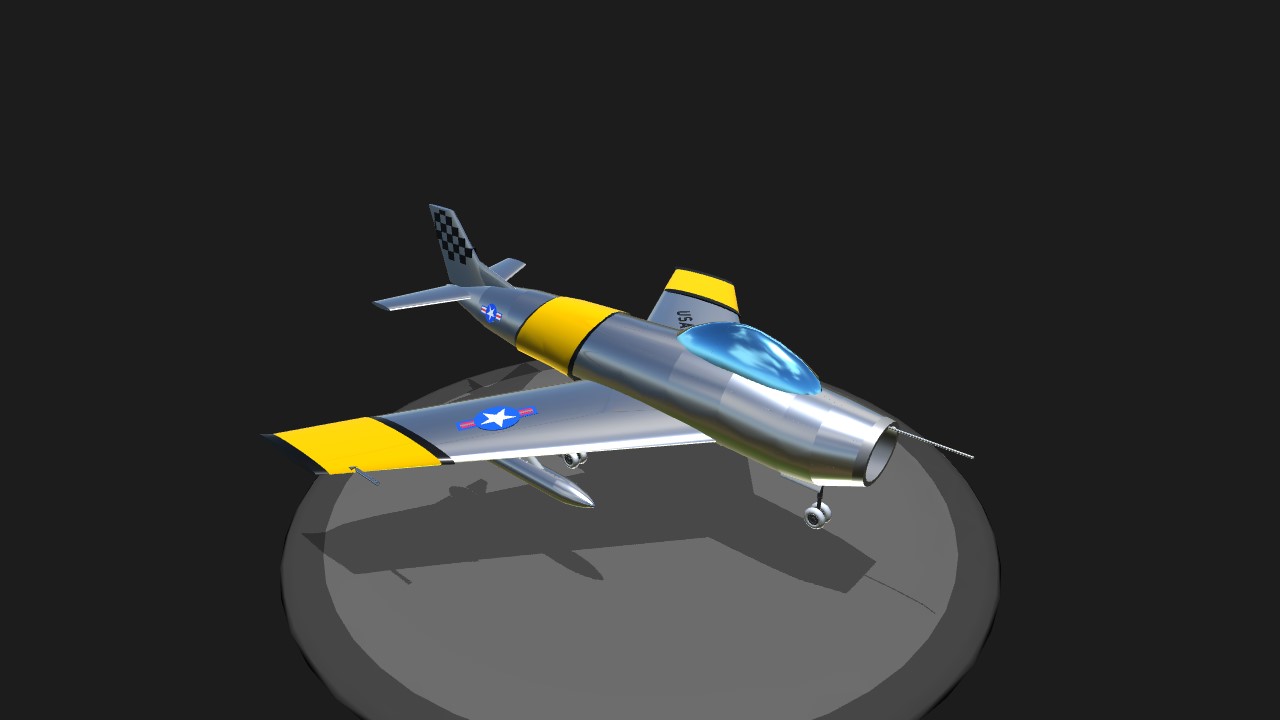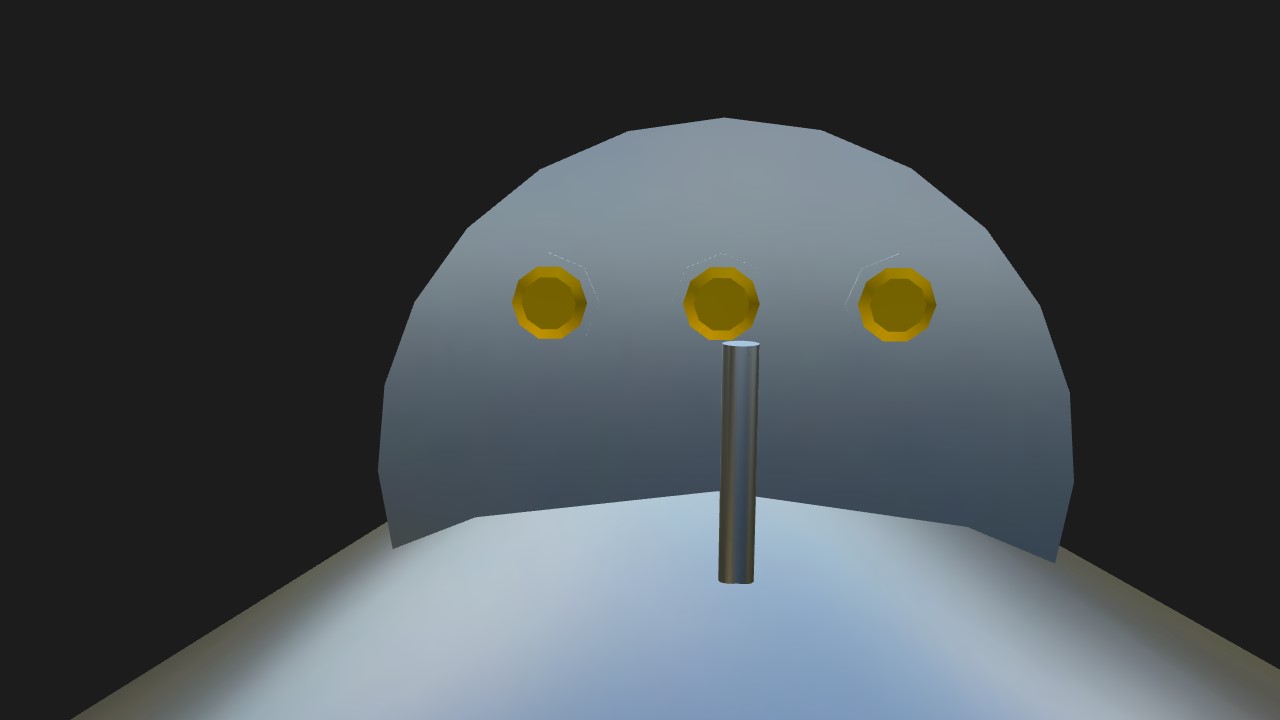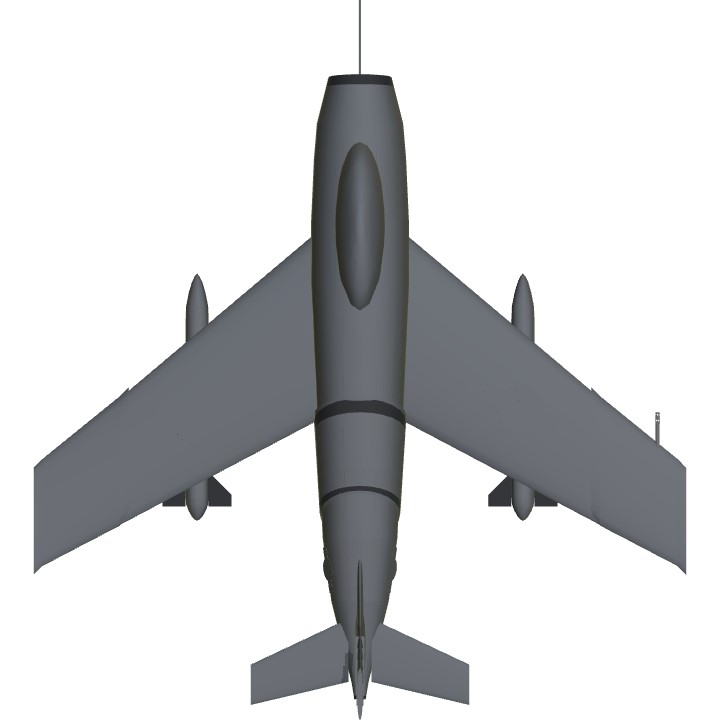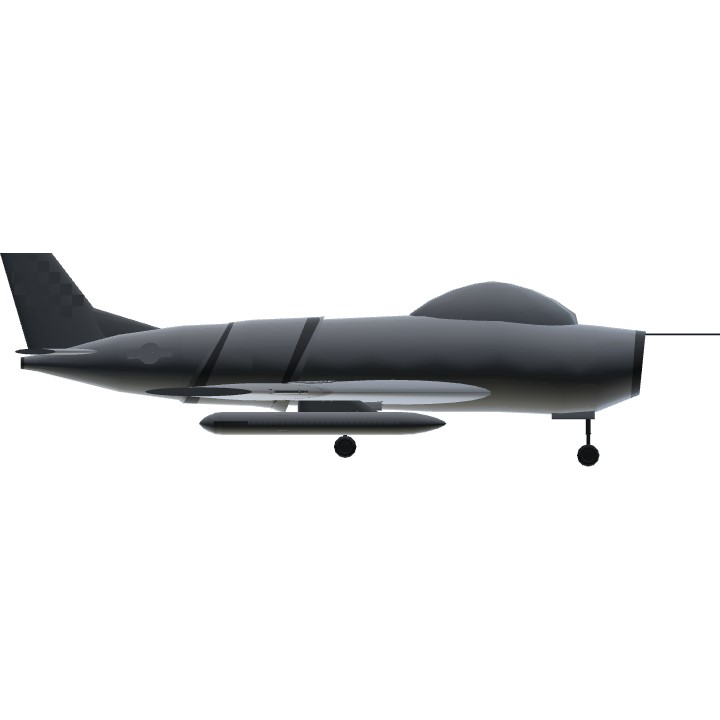The North American F-86 Sabre, sometimes called the Sabrejet, is a transonic jet fighter aircraft. Produced by North American Aviation, the Sabre is best known as the United States' first swept-wing fighter that could counter the swept-wing Soviet MiG-15 in high-speed dogfights in the skies of the Korean War (1950–1953), fighting some of the earliest jet-to-jet battles in history. Considered one of the best and most important fighter aircraft in that war, the F-86 is also rated highly in comparison with fighters of other eras.[3] Although it was developed in the late 1940s and was outdated by the end of the 1950s, the Sabre proved versatile and adaptable and continued as a front-line fighter in numerous air forces until the last active operational examples were retired by the Bolivian Air Force in 1994.[citation needed]
F86F Sabres - Chino Airshow 2014 (cropped).jpg
A North American F-86 over the Planes of Fame Air Museum in Chino, California
Role
Fighter aircraft
National origin
United States
Manufacturer
North American Aviation
First flight
1 October 1947
Retired
1965 (USAF)
1994 (Bolivia)
Status
Retired, some still used as warbirds
Primary users
United States Air Force
Japan Air Self-Defense Force
Spanish Air Force
Republic of Korea Air Force
Number built
9,860[1]
Unit cost
US$219,457 (F-86E)[2]
Developed from
North American FJ-1 Fury
Variants
CAC Sabre
Canadair Sabre
North American F-86D Sabre
North American FJ-2/-3 Fury
Developed into
North American FJ-4 Fury
North American YF-93
North American F-100 Super Sabre
Its success led to an extended production run of more than 7,800 aircraft between 1949 and 1956, in the United States, Japan, and Italy. In addition, 738 carrier-modified versions were purchased by the US Navy as FJ-2s and -3s. Variants were built in Canada and Australia. The Canadair Sabre added another 1,815 airframes, and the significantly redesigned CAC Sabre (sometimes known as the Avon Sabre or CAC CA-27), had a production run of 112. The Sabre is by far the most-produced Western jet fighter, with total production of all variants at 9,860 units.[1]
North American Aviation had produced the propeller-powered P-51 Mustang in World War II, which saw combat against some of the first operational jet fighters. By late 1944, North American proposed its first jet fighter to the U.S. Navy, which became the FJ-1 Fury. It was an unexceptional transitional jet fighter that had a straight wing derived from the P-51.[4][5] Initial proposals to meet a United States Army Air Forces (USAAF) requirement for a medium-range, single-seat, high-altitude, jet-powered day escort fighter/fighter bomber were drafted in mid-1944.[6] In early 1945, North American Aviation submitted four designs.[6] The USAAF selected one design over the others, and granted North American a contract to build three examples of the XP-86 ("experimental pursuit"). Deleting specific requirements from the FJ-1 Fury, coupled with other modifications, allowed the XP-86 to be lighter and considerably faster than the Fury, with an estimated top speed of 582 mph (937 km/h), versus the Fury's 547 mph (880 km/h).[6] Despite the gain in speed, early studies revealed the XP-86 would have the same performance as its rivals, the XP-80 and XP-84. Because these rival designs were more advanced in their development stages, it was feared that the XP-86 would be cancelled.
Crucially, the XP-86 was not able to meet the required top speed of 600 mph (970 km/h);[7] North American had to quickly devise a radical change that could leapfrog its rivals. The North American F-86 Sabre was the first American aircraft to take advantage of flight research data seized from the German aerodynamicists at the end of World War II.[8] These data showed that a thin, swept wing could greatly reduce drag and delay compressibility problems that had bedeviled fighters such as the Lockheed P-38 Lightning when approaching the speed of sound. By 1944, German engineers and designers had established the benefits of swept wings based on experimental designs dating back to 1940. Study of the data showed that a swept wing would solve their speed problem, while a slat on the wing's leading edge that extended at low speeds would enhance low-speed stability.
Because development of the XP-86 had reached an advanced stage, the idea of changing the sweep of the wing was met with resistance from some senior North American staff. Despite stiff opposition, after good results were obtained in wind tunnel tests, the swept-wing concept was eventually adopted. Performance requirements were met by incorporating a 35° swept-back wing, using modified NACA four-digit airfoils, NACA 0009.5–64 at the root and NACA 0008.5–64 at the tip,[9] with an automatic slat design based on that of the Messerschmitt Me 262 and an electrically adjustable stabilizer, another feature of the Me 262A.[10][11][12] Many Sabres had the "6–3 wing" (a fixed leading edge with a 6-inch extended chord at the root and a 3-inch extended chord at the tip) retrofitted after combat experience was gained in Korea.[10][13] This modification changed the wing airfoils to the NACA 0009-64 mod at the root and the NACA 0008.1–64 mod at the tip.[9]
The XP-86 prototype, which led to the F-86 Sabre, was rolled out on 8 August 1947.[14] The first flight occurred on 1 October 1947 with George Welch at the controls,[15] flying from Muroc Dry Lake (now Edwards AFB), California.[8][14]
The United States Air Force's Strategic Air Command had F-86 Sabres in service from 1949 through 1950. The F-86s were assigned to the 22nd Bomb Wing, the 1st Fighter Wing, and the 1st Fighter Interceptor Wing.[16] The F-86 was the primary U.S. air combat fighter during the Korean War, with significant numbers of the first three production models seeing combat.
The F-86 Sabre was also produced under license by Canadair, Ltd, as the Canadair Sabre. The final variant of the Canadian Sabre, the Mark 6, is generally rated as having the highest capabilities of any Sabre version.[17][Note 1]
Breaking sound barrier and other records
Jackie Cochran in the cockpit of the Canadair Sabre with Chuck Yeager
The F-86A set its first official world speed record of 671 miles per hour (1,080 km/h) on September 15, 1948, at Muroc Dry Lake, flown by Major Richard L. Johnson, USAF.[18] Five years later, on 18 May 1953, Jacqueline Cochran became the first woman to break the sound barrier, flying a "one-off" Canadian-built F-86 Sabre Mk 3, alongside Chuck Yeager.[2] Col. K. K. Compton won the 1951 Bendix air race in an F-86A with an average speed of 553.76 mph (891.19 km/h).
Sabre at NASM in livery of 4th Fighter-Interceptor Wing
The F-86 was produced as both a fighter-interceptor and fighter-bomber. Several variants were introduced over its production life, with improvements and different armament implemented (see below). The XP-86 was fitted with a General Electric J35-C-3 jet engine that produced 4,000 lbf (18 kN) of thrust. This engine was built by GM's Chevrolet division until production was turned over to Allison.[19] The General Electric J47-GE-7 engine was used in the F-86A-1 producing a thrust of 5,200 lbf (23 kN), while the General Electric J73-GE-3 engine of the F-86H produced 9,250 lbf (41 kN) of thrust.[20]
The fighter-bomber version (F-86H) could carry up to 2,000 lb (907 kg) of bombs, including an external fuel-type tank that could carry napalm.[21] Unguided 2.75 in (70 mm) rockets were used on some fighters on training missions, but 5-inch (127 mm) rockets were later carried on combat operations. The F-86 could also be fitted with a pair of external jettisonable jet fuel tanks (four on the F-86F beginning in 1953) that extended the range of the aircraft. Both the interceptor and fighter-bomber versions carried six 0.50 in (12.7 mm) M3 Browning machine guns with electrically boosted feed in the nose (later versions of the F-86H carried four 20 mm (0.79 in) cannon instead of machine guns). Firing at a rate of 1,200 rounds per minute,[22] the 0.50 in guns were harmonized to converge at 1,000 ft (305 m) in front of the aircraft, using armor-piercing (AP) and armor-piercing incendiary (API) rounds, with one armor-piercing incendiary tracer (APIT) for every five AP or API rounds. The API rounds used during the Korean War contained magnesium, which were designed to ignite upon impact, but burned poorly above 35,000 ft (11,000 m) as oxygen levels were insufficient to sustain combustion at that height. Initial planes were fitted with the Mark 18 manual-ranging computing gun sight. The last 24 F-86A-5-Nas and F-86Es were equipped with the A-1CM gunsight-AN/APG-30 radar, which used radar to automatically compute a target's range, which later proved to be advantageous against MiG opponents over Korea.[23]
Flying characteristics Edit
The Sabre's swept wings and jet engine produced a flying experience that was very different from the propeller-driven fighters of the time. The transition from props to jets was not without accidents and incidents even for experienced fighter pilots. Early on in the jet age, some US manufacturers instituted safety and transition programs where experienced test and production pilots toured operational fighter squadrons to provide instruction and demonstrations designed to lower the accident rate.[24]
Additionally, the ongoing technical development and long production history of the F-86 resulted in some significant differences in the handling and flying characteristics between the various F-86 models. Some of the important changes to the design included the switch from an elevator/stabilizer to an all-flying tail, the discontinuation of leading edge slats for a solid leading edge with increased internal fuel capacity, increased engine power, and an internal missile bay (F-86D). Each of these design changes impacted the handling and flying characteristics of the F-86, not necessarily for the better. In the case of the solid leading edge and increased internal fuel capacity, the design change produced increased combat performance, but exacerbated a dangerous and often fatal handling characteristic upon take-off if the nose were raised prematurely from the runway.[25] This 'over-rotation' danger is now a major area of instruction and concern for current F-86 pilots. The 1972 Sacramento Canadair Sabre accident resulting in 22 fatalities and 28 other casualties was a result of over-rotation on take-off.
Specifications
General Characteristics
- Created On iOS
- Wingspan 46.5ft (14.2m)
- Length 51.3ft (15.6m)
- Height 15.2ft (4.6m)
- Empty Weight 15,577lbs (7,065kg)
- Loaded Weight 20,452lbs (9,276kg)
Performance
- Power/Weight Ratio 0.164
- Wing Loading 42.6lbs/ft2 (207.9kg/m2)
- Wing Area 480.3ft2 (44.6m2)
- Drag Points 11734
Parts
- Number of Parts 191
- Control Surfaces 7
- Performance Cost 685






Thank you @SledDriver
@Jwpdaviesjr
The text you want the link to say goes between square brackets, and the link itself goes between parentheses:
[Wiki](https://en.wikipedia.org/wiki/North_American_F-86_Sabre)The code above will create a link like this:
Wiki
How do I make links?@SledDriver
Nice build, but you could just post a link to the Wikipedia article, you know : )
If you need help to make this fly better, just ask.